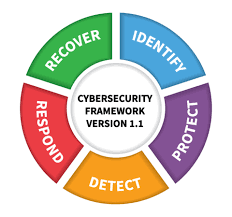 The first version of the NIST Cybersecurity Framework came about in Feb. 2014. In May 2017 President Donald Trump issued an executive order directing all federal agencies to use the framework to manage this risk, including future versions. Conversely, the private sector more so uses it as a non-uniform guide (sometimes in part) when needed. They use other more industry specific frameworks as well. On 04/17/18 NIST released the updated version of this standard-setting framework. We attended the NIST hosted webcast reviewing this on 04/27/18 and my key points are:
The first version of the NIST Cybersecurity Framework came about in Feb. 2014. In May 2017 President Donald Trump issued an executive order directing all federal agencies to use the framework to manage this risk, including future versions. Conversely, the private sector more so uses it as a non-uniform guide (sometimes in part) when needed. They use other more industry specific frameworks as well. On 04/17/18 NIST released the updated version of this standard-setting framework. We attended the NIST hosted webcast reviewing this on 04/27/18 and my key points are:
Framework 7 Step Process:
1) Prioritize and Scope: Implementation tiers may be used to express varying risk tolerances.
2) Orient
3) Create a Current Profile
4) Conduct a Risk Assessment
5) Create a Target Profile: When used in conjunction with an Implementation Tier, characteristics of the Tier level should be reflected in the desired cybersecurity outcomes.
6) Determine, Analyze, and Prioritize Gaps
7) Implementation Action Plan
These recent changes to the framework are based on feedback collected through public calls for comments, questions received by team members, and workshops held from 2016 to 2017.
The newest version (1.1) includes these updates:
1) Clarifies utility as a structure and language for organizing and expressing compliance with an organization’s own cybersecurity requirements.
2) Added a new section for self-assessing cybersecurity risk which explains how organizations can use the framework. Emphasizes the role of measurements in self-assessment stresses critical linkage of business results:
- Cost
- Benefit
- to cybersecurity risk management
- Continued discussion of this linkage will occur under
- Roadmap area – Measuring Cybersecurity
3) Added a new section for supply chain risk management which focuses on identifying, assessing, and mitigating acquired products and services that may contain malicious functionality, be counterfeit, or have critical vulnerabilities because of poor manufacturing practices.
4) Added new focus area for small business – what this means is yet to be seen.
“Engagement and collaboration will continue to be essential to the framework’s success,” said Matt Barrett of NIST. “The Cybersecurity Framework will need to evolve as threats, technologies and industries evolve. With this update, we’ve demonstrated that we have a good process in place for bringing stakeholders together to ensure the framework remains a great tool for managing cybersecurity risk”, he said.
PwC’s 2018 Global State of Information Security Survey (GSISS) indicated that respondents from healthcare payer and provider organizations, as well as oil and gas companies, said the NIST Cybersecurity Framework is the most commonly adopted set information security standards in their respective industries.
In another case, the University of Chicago’s Biological Sciences Division (BSD) successfully implemented the Cybersecurity Framework to help them comply with HIPAA and other federal data security rules.
If you want to know how to customize this to your organization please contact us.

